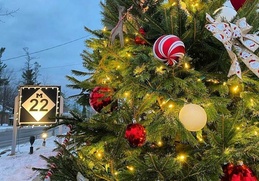Burnout
March 22, 2015
The Burt Lake Band Strives For recognition and restitution
A group of Cheboiganing Indians, whose ancestors spent centuries living in a Burt Lake village, want something both stunningly simple and painfully complicated: federal government acknowledgement that they exist.
Efforts for Bureau of Indian Affairs recognition have failed since the 1980s, but what’s now known as the Burt Lake Band of Ottawa and Chippewa Indians continues to work for reaffirmation. This year, with the help of former U.S. representative Bart Stupak, the Burt Lake Band (BLB) hopes to find legitimacy through the BIA or an act of Congress.
THE NOTORIOUS BURNOUT
The BLB’s identity loss began with one of the most notorious events in northern Michigan history: the Indian Village "burnout" of Oct. 15, 1900.
At the time, tribe members believed their village on a 1,000-acre peninsula on the western shore of Burt Lake had been ceded to them in treaty negotiations and that the land was held in trust, out of the tax collector’s reach. Instead, local officials had sporadically assessed property taxes on the land over a period of years and it finally fell into foreclosure.
A wealthy timber speculator snatched up the parcels in exchange for back taxes and enlisted the Cheboygan County Sheriff to enforce a court order to have the tribal members removed.
The sheriff and speculator chose a rainy fall day when the men of the village would be miles away, collecting paychecks in Cheboygan. The women, children and elderly who were left behind were helpless when the 19 families were forced from their homes. The buildings were doused with kerosene and set ablaze. A Catholic church was the only structure spared. The tribal members fled, many of them first to Cross Village, and the BLB has been without a geographic center ever since.
"After the burnout, and the ensuing years that followed, it’s kind of like a bomb going off," said Bruce Hamlin, the 43-year-old chairman of the Burt Lake Band since 2010. "You don’t just leave the village. You scatter."
"˜A BROKEN PROCESS’
Hamlin heard very little about the burnout growing up, though his family was among those forced out of what was known as Indian Village.
"I grew up downstate," said Hamlin, who lives in Fenton. "My dad wasn’t politically involved in the tribal things when I was growing up and I didn’t really get involved until I was older."
Recently, Hamlin has been busy trying to facilitate the BLB’s reaffirmation, a status change that would allow tribal members access to healthcare through the federal government, among other things.
Reaffirmation could happen administratively through the BIA, which is under the US Department of the Interior, or politically through an act of Congress.
Establishing proof of existence as a tribe with the BIA is difficult under the best of circumstances. It can require records going back more than a hundred years, which may or may not exist.
"That’s the whole thing. Everyone knows now, even the higher ups at the bureau – Sally Jewell, secretary of the interior – they all talk about the process that you go through. It’s just a broken process," Hamlin said. "It was set up to make tribes fail. They admit this openly."
Hamlin said the BLB should already be recognized as an existing tribe because its members signed the original treaties that brought a third of Michigan land under control of the United States: the 1836 Treaty of Washington and the 1855 Treaty of Detroit. Hamlin believes the BLB should not be trapped in the bureaucratic netherworld they find themselves.
"Adding to the frustration is, as a tribe that’s a signatory to treaties, we never belonged in the BIA process to begin with," Hamlin said. "We should have been dealing directly with the Secretary of the Interior."
A CONGRESSMAN IN THEIR CORNER
Stupak, who today works for Venable LLC, a law firm in Washington D.C, said reaffirmation through the BIA will become more viable this year because the bureau is rewriting its rules on recognition of Indian tribes to make them less subjective.
"We’re optimistic that once these new standards come out, it may give us a better option there than legislatively," Stupak said.
An additional difficulty for the BLB is that, over the years, the roughly 300 members of the tribe have spread out geographically, including some who, lured by medical benefits, have joined the Little Traverse Bay Band of Odawa Indians.
In order to be reaffirmed, Stupak said, the tribe has to prove "continuity in their existence since 1855."
"No one doubts that they’re signatories to the treaties, the Treaty of 1836 and the Treaty of 1855. That’s not really the issue," Stupak said. "The argument has been [that] because the tribal members who are the Burt Lake Band have sought and received services elsewhere, it’s not necessary to reaffirm this tribe."
Stupak said he introduced legislation to reaffirm the tribe four or five times when he was a congressman and he believes it would have been successful were it not for Jack Abramoff, the lobbyist imprisoned after a corruption scandal that involved work on behalf of Indian tribes, among other things. Stupak said the scandal scared many lawmakers away from Native American issues.
Reaffirmation for the Burt Lake Band should be just the first step toward justice, Stupak said. He also believes the BLB is owed restitution for the burnout.
"I still think there’s a greater issue here, of land that was improperly taken, and they’ve never really been compensated," Stupak said. "There’s a lot of injustice that has to be addressed, more than just reaffirmation."
UNSURE WHAT IS OWED 
Hamlin isn’t certain what would constitute fair restitution.
He said the BLB does not intend to seek the recovery of the land that was lost in the burnout; it’s become expensive lakefront resort property. A 1.39-acre vacant waterfront lot is currently listed for sale at $695,000.
"That’s probably impossible, to get back the actual square footage, land and lakefront that we lost," Hamlin said. "Would it be nice? Yeah, but you’d have a lot of upset homeowners up there and we don’t want to cause an uprising or anything. We would like some land back. We would like some land."
Hamlin said there is state land nearby that might be suitable.
"There’s plenty of land on Indian Road and in the surrounding areas that we could hopefully negotiate, but first we have to just reestablish our recognition, and the land settlement would have to be part of that," he said.
Hamlin said he hasn’t attempted to place a dollar value on what was lost.
"There’s a peninsula that juts out into Burt Lake and that 1,000 acres is the Burt Lake Band’s 1,000 acres from the treaty. Now that is some of the most beautiful land, lakefront land, in northern Michigan," he said.
"So, you can imagine, if one of those homes goes for one or two million, you do the math. That’s probably got a lot to do with why we haven’t been set right."
"˜WE’LL AGREE NOT TO GAME’
Hamlin isn’t certain whether any group or interest is actively working against Burt Lake’s effort to be recognized, but he does suspect some interests are against them behind-the-scenes. He believes the gambling industry in general opposes recognition of new Indian tribes.
"I
think that it’s widely known that all casino owners – not just in
Michigan, all over the country – they’re very much opposed to any new
casinos," Hamlin said. "Anyone who learns about us, they say, "˜Oh, this
is just about a casino and blah blah blah.’ Behind the scenes, they will
oppose you. They’ll put out money to stop things. And it’s not about a
casino. It’s just about our treaty rights, which are irrevocable, or
supposed to be, and just getting back what we are owed." 
Hamlin said that, in exchange for reaffirmation, the BLB would give up its claim to open a casino.
"I think our goal is just to get what we’re owed and if that means federal recognition, getting the land back and any funds that we’re owed from settlements, that’s what we want," Hamlin said. "If a casino becomes part of it, then perhaps opting out of a casino would be part of it. If opposition to our recognition because of a casino is holding us back, maybe we could negotiate and say, "˜This is our gaming compact – we’ll agree not to game.’ There’s ways to barter with that. So it’s not about a casino."
If there truly is opposition to Burt Lake’s bid for reaffirmation, it’s not from their neighboring tribe. In 2012, the Little Traverse Bay Band’s tribal council passed a declaration of support for the Burt Lake Band’s effort to become reaffirmed by the BIA.
IT WAS IMMORAL, BUT WAS IT LEGAL?
The consensus among local historians is that the 1900 burnout was an immoral act. The disagreement is over whether it was legal.
A 2007 article published in the Michigan Historical Review clearly states that the action was abhorrent, but legal.
"Although it was unquestionably immoral, the eviction of the Indians and the burning of Indian Village were within the law," Matthew Friday wrote in the article. Friday, then a graduate student, is now executive director of the Cheboygan Area Chamber of Commerce.
In an email to the Express, Friday explained that, due to his current position, he would not comment on the article.
In his article, Friday argued the Indian Village burnout was a demonstration of how whites used tax law to snap up land from Native Americans.
"Historians have asserted that the destruction of Indian Village and the seizure of the occupants’ land were criminal acts, but the facts underlying the case reveal that these acts were not illegal, but rather the result of confusion regarding treaties, trusts and tax laws," Friday wrote.
Hamlin said Friday’s interpretation is wrong.
"When land is put in trust, it’s in trust forever," he said. "That’s the whole thing. There’s not very many of these cases where land was put in trust by the federal government and then it was later revoked. The misunderstanding was at the local level."
"˜IT WAS NEVER LEGAL’
Richard Wiles, a retired high school teacher and a local historian, said Friday’s article spurred him to become an advocate for the Burt Lake Band.
"It was never a legal burnout," he said. "It was always an illegal burnout that was sanctified by the good old boys."
Wiles believes the BLB was permanently ceded the 1,000 acres in the treaties and that subsequent legal decisions that contradicted that were in error.
"It was an immoral, unjust, cruel and totally illegal act only allowed to stand because of malfeasance by state and federal government officials," Wiles said. "I know it seems incredible that this thing is 115 years old and it’s never been made right."
Wiles has donated hundreds of pages of documents that support his position to the History Center of Cheboygan County.
Lewis Crusoe, the center’s executive director, said he hasn’t able to read all of the material yet, but he considers the question of whether the burnout was technically legal to be an important one. The museum recruited a retired attorney to take a look at the documents and offer an opinion.
"Not having read all the documents myself and not having met with the attorney, I don’t think we should take a stand officially," Crusoe said.
Crusoe said he personally suspects, like Friday, that although the land grab was immoral, it was legal.
"Slavery was legal in this country at one time," he said.
Trending

Strolling Lights, Feeding Neighbors
Help those in need by decorating a tree at the fifth annual Strolling Lights Festival in Glen Arbor! By sponsoring a tree fo… Read More >>
Off to Wonderland in Manistee
Fresh off the spooky fun of It Was a Dark and Stormy Night, and acting as the bridge between that show from the Manistee Civ… Read More >>
Affordable Menstrual Products Up North
Northwestern Michigan College health science student Zinnia Burks wants to understand the prevalence of “period povert… Read More >>


